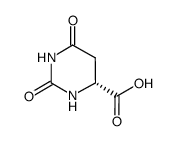D-Hydroorotic Acid

D-Hydroorotic Acid structure
|
Common Name | D-Hydroorotic Acid | ||
|---|---|---|---|---|
| CAS Number | 5988-53-4 | Molecular Weight | 158.11200 | |
| Density | 1.523 g/cm3 | Boiling Point | N/A | |
| Molecular Formula | C5H6N2O4 | Melting Point | 255ºC (dec.)(lit.) | |
| MSDS | Chinese USA | Flash Point | N/A | |
| Symbol |

GHS07 |
Signal Word | Warning | |
|
The structures of human dihydroorotate dehydrogenase with and without inhibitor reveal conformational flexibility in the inhibitor and substrate binding sites.
Biochemistry 47(34) , 8929-36, (2008) Inhibitors of dihydroorotate dehydrogenase (DHODH) have been suggested for the treatment of rheumatoid arthritis, psoriasis, autoimmune diseases, Plasmodium, and bacterial and fungal infections. Here we present the structures of N-terminally truncated (residu... |
|
|
Miller (Genee-Wiedemann) syndrome represents a clinically and biochemically distinct subgroup of postaxial acrofacial dysostosis associated with partial deficiency of DHODH.
Hum. Mol. Genet. 21(18) , 3969-83, (2012) Biallelic mutations in the gene encoding DHOdehase [dihydroorotate dehydrogenase (DHODH)], an enzyme required for de novo pyrimidine biosynthesis, have been identified as the cause of Miller (Genée-Weidemann or postaxial acrofacial dysostosis) syndrome (MIM 2... |
|
|
Biochemical and molecular characterization of the pyrimidine biosynthetic enzyme dihydroorotate dehydrogenase fromToxoplasma gondii
Mol. Biochem. Parasitol. 184(2) , 71-81, (2012) Graphical abstract Toxoplasma gondii dihydroorotate dehydrogenase is an essential mitochondrial enzyme that exhibits inhibitor sensitivities distinct from those of the human and Plasmodium falciparum enzymes. |
|
|
Site directed spin labeling studies of Escherichia coli dihydroorotate dehydrogenase N-terminal extension.
Biochem. Biophys. Res. Commun. 414(3) , 487-92, (2011) Dihydroorotate dehydrogenases (DHODHs) are enzymes that catalyze the fourth step of the de novo synthesis of pyrimidine nucleotides. In this reaction, DHODH converts dihydroorotate to orotate, using a flavine mononucleotide as a cofactor. Since the synthesis ... |
|
|
Thermodynamic basis of electron transfer in dihydroorotate dehydrogenase B from Lactococcus lactis: analysis by potentiometry, EPR spectroscopy, and ENDOR spectroscopy.
Biochemistry 43(21) , 6498-510, (2004) Dihydroorotate dehydrogenase B (DHODB) is a complex iron-sulfur flavoprotein that catalyzes the conversion of dihydroorotate to orotate and the reduction of NAD(+). The enzyme is a dimer of heterodimers containing an FMN, an FAD, and a 2Fe-2S center. UV-visib... |
|
|
Mutations in yhiT enable utilization of exogenous pyrimidine intermediates in Salmonella enterica serovar Typhimurium.
Microbiology 153(Pt 8) , 2472-82, (2007) Mutants capable of utilizing the pyrimidine biosynthetic intermediates carbamoylaspartate and dihydroorotate for growth were derived from pyrimidine auxotrophs of Salmonella enterica serovar Typhimurium LT2. The gain-of-function phenotypes both resulted from ... |
|
|
Kinetic mechanism and catalysis of Trypanosoma cruzi dihydroorotate dehydrogenase enzyme evaluated by isothermal titration calorimetry.
Anal. Biochem. 399(1) , 13-22, (2010) Trypanosoma cruzi dihydroorotate dehydrogenase (TcDHODH) catalyzes the oxidation of l-dihydroorotate to orotate with concomitant reduction of fumarate to succinate in the de novo pyrimidine biosynthetic pathway. Based on the important need to characterize cat... |
|
|
Mechanism of the dihydroorotase reaction.
Biochemistry 43(51) , 16285-92, (2004) Dihydroorotase (DHO) is a zinc metalloenzyme that functions in the pathway for the biosynthesis of pyrimidine nucleotides by catalyzing the reversible interconversion of carbamoyl aspartate and dihydroorotate. A chemical mechanism was proposed on the basis of... |
|
|
Dihydroorotase from the hyperthermophile Aquifex aeolicus is activated by stoichiometric association with aspartate transcarbamoylase and forms a one-pot reactor for pyrimidine biosynthesis.
Biochemistry 48(4) , 766-78, (2009) In prokaryotes, the first three enzymes in pyrimidine biosynthesis, carbamoyl phosphate synthetase (CPS), aspartate transcarbamoylase (ATC), and dihydroorotase (DHO), are commonly expressed separately and either function independently (Escherichia coli) or as... |
|
|
Mechanism of flavin reduction in class 2 dihydroorotate dehydrogenases.
Biochemistry 45(50) , 14926-32, (2006) Dihydroorotate dehydrogenases (DHODs) oxidize dihydroorotate (DHO) to orotate using the FMN prosthetic group to abstract a hydride equivalent from C6 and a protein residue (Ser for Class 2 DHODs) to deprotonate C5. The fundamental question of whether the scis... |